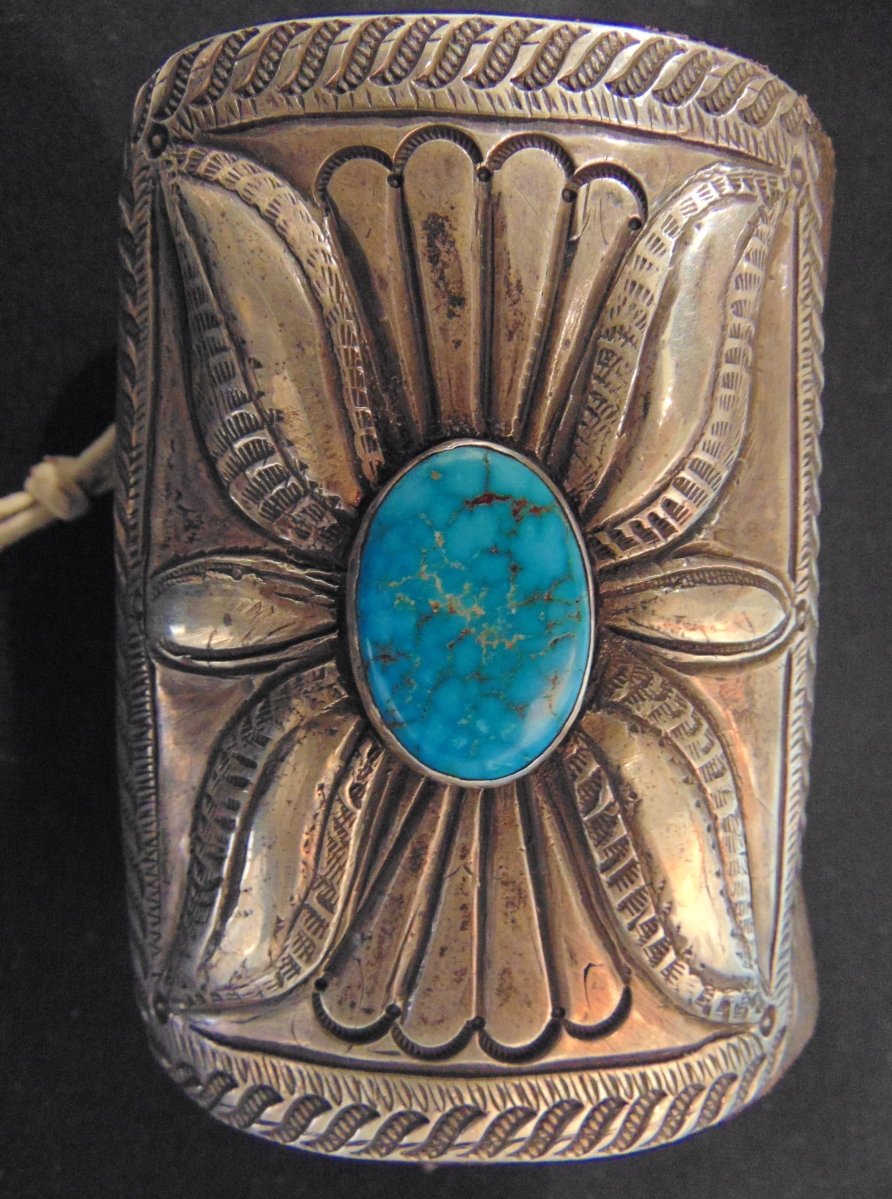
French American sculptor Roger Voisin conducted in-depth studies of the life of American Indians and here captures “The Hunt” in bronze. Shown by Gabe Starace’s Looking West Art Gallery, Old Hickory, Tenn.
Review and Photos By Walt Borton
SANTA FE – Running August 15-17, the three days prior to Santa Fe’s 96-year-old Indian Market, the Antique American Indian Art Show is an intimate, beautifully mounted, almost museum-like antiques event. The show is perfectly juxtaposed with the sprawling, juried street fair of contemporary Indian artists that annually engulfs the city’s downtown to make any visitor’s Santa Fe experience more fun and meaningful.
That is no accident. Five years ago, when making the decision to launch the Antique American Indian Art Show, co-producers Kim Martindale and John Morris were responding to two challenges.
First, 35 years before, as a teen, Martindale was the first show-runner for Don Bennett’s original August trio of Santa Fe antiques shows, colloquially known as the “Cowboy,” “Indian” and “Ethno” shows, which by 2013 had been collapsed into a single event under new ownership.
That year, Martindale wrote to potential dealers for a new Antique American Indian Art Show describing why he believed such a show was needed, saying, “The fine art world is now far more understanding and appreciative of the intrinsic importance of the antique works of unknown Native American artists; artists motivated not by recognition, but by the challenges of achieving perfect aesthetic execution in the context of their complex culture. And the ethical/governmental world now actively chooses to respect and protect the cultural and societal values preserved in the art of Native People.”
Second, as the world of contemporary Indian art, powerfully presented by Indian Market, evolved toward more innovative and cutting-edge articulations of traditional art forms, Martindale and Morris believed it essential that the cultural and aesthetic heritage of those evolving art forms be made available as a part of the art experience in Santa Fe.

The saddle blanket and small blanket portion of the special rug exhibit, “Germantown Weaving: First Modern Art — 1870–1900.”
The resulting Antique American Indian Art Show offers a pathway from historical American Indian art into today’s world of contemporary Indian Art, a visual transition replete with history, artistry and captivating beauty.
Those who have experienced the “important” art and antiques shows both home and abroad understand that while cluttered and overflowing booths can be much fun and sometimes yield surprising treasures, the powerful and most important experiences happen when a work is presented with sufficient space to let the eye explore it and focus on it alone.
By that standard, this show is moving deliberately toward that “important” category. Across the floor, exhibitor booths are large, providing the wall space important work requires and offering aisles wide enough for a visitor to contemplate a work without becoming an obstacle to traffic.
The caliber of the work and the repute of the dealers are, however, even more important standards. There too, the Antique American Indian Art Show is, after just five years, making a strong argument for stature as one of the most important shows of its kind in the world.
Dominating the curated show floor this year was a cadre of highly respected field-expert-dealers, including Jeff Hengesbaugh, Ted Trotta and Anna Bono, Robert Gallegos, Mark Sublette, John Malloy, James Flurry, Brant Mackley, Terry DeWald and Philip Garaway. Thomas Cleary, former director of Malcom Grimmer’s gallery, is now out on his own with a formidable presentation, and Dan Wasko, a relative newcomer to the field, also brings a fresh eye for intriguing material to the floor. John C. Hill Antique Indians Arts and John Krena’s Four Winds Gallery presented a powerful corner booth of pottery, objects and important textiles, which were complimented by those offered by Chimayo Trading del Norte’s Gabriel Abrums. And when Jane Buchsbaum, whose name graces the Buchsbaum Gallery of Southwestern Pottery at Santa Fe’s Museum of Indian Arts and Culture says, “I was happy to see Gary and Patty Klepper here, I always buy a pot from them,” you get the feeling you are where you are supposed to be.
The show is not overwhelmed with jewelry, but what is presented is both worthy and well-shown at the booths of Turkey Mountain Traders, Bud Callahan, Miles and Miles, Susan Swift and the team of Lou DeFusco and Holly Luring. Cowboys and Indians, helmed by Terry Schurmeier, aligned three seamless booths with Victoria Roberts and Jan and Peter Duggan to offer a worthy combination of jewelry and objects, and almost as importantly, the kind of welcoming space that only decades of friendship in “the trade” can offer.
The show’s flat art was dominated by the ongoing special exhibition, Mark Sublette’s comprehensive “Maynard Dixon’s New Mexico Centennial,” which presented more than 100 paintings, drawings and documents that offered a deep dive into Dixon’s work as an artist. But the field was well rounded out by Blue Rain Gallery, Looking West Gallery and Stevens Fine Art, where Steve Stoops featured fascinating work by significant American Indian painters, including an extremely rare abstract work by Pablita Velarde.
The special exhibit “Germantown Weaving: First Modern Art – 1870-1900” brought from California a spectacular display of 80 Navajo Germantown examples. This extraordinary collection is one of the largest and rarest in the world, displaying a variety of brilliantly colored, meticulously designed weavings.
Lectures for the show included “A History of Giving: Stewardship of private collections at the IARC,” by Brian Vallo, director of the Indian Arts Research Center at the School for Advanced Research and “The Legacy of Allan Houser and His Impact on the Native Art World,” by David Rettig, curator of collections for Allan Houser Inc.
This year’s Antique American Indian Art Show again previewed with an evening benefit for KNME New Mexico PBS. Show producers estimate that the show gate exceeded last year by 20 percent.
For additional information, www.antiqueindianartshow.com or 310-822-9145.







.jpg)























